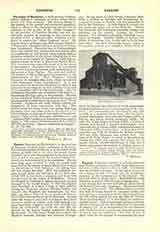

Faenza, Diocese of (FAVENTINA), in the province of Ravenna (Central Italy), suffragan of Ravenna. The earliest mention of this city is in the report of the victory of Sulla (82 B.C.) over the consul Cneius Papirius Carbo, who was compelled to flee from Italy. In A.D. 728 it was seized by the Lombard king, Liutprand, who later restored it to the exarchate. But the same king again attacked it, while the people were assembled in the church of Santa Maria Foris Portam for the services of Holy Saturday; the bishop himself was among the slain. With the exarchate Faenza passed under the authority of the Holy See. About 1000 it was made a commune and from 1100 was governed by the counts of Modigliana. During the struggle of Frederick II against the popes, the city belonged to the Guelph league; in 1241 the emperor took possession of it after a siege of eight months. During the thirteenth century different families, the Accarisi, the Manfredi, the Lambertazzi, the Nordigli, and others, disputed by possession of Faenza. From1294 it was governed by the Manfredi. Several times the Avignon popes had to summon these lords to render service as vassals, as in 1328 through Cardinal Bertrando Poggetto and in 1356 through Cardinal Gil dAlbornoz. In 1378 the city was destroyed by the famous English condottiere, Sir John Hawkwood. In 1501 Caesar Borgia put to death the Manfredi brothers, Astorgio and Giovanni Evangelista. On the death of Caesar Borgia, Francesco Manfredi, a brother of Astorgio and Evangelista, attempted to return to Faenza, but was compelled to flee by the Venetians. In 1509 Julius II brought the city under the direct rule of the Holy See. During the thirteenth and fourteenth centuries Faenza was renowned for its pottery (whence the French faïence). The celebrated physicist, Torricelli, was a native of Faenza. Domitia Lucilla, a martyr, the widow of Antoninus Pius, is also said to have been born there. The first historically certain bishop is Constantius, present at a council in Rome (313), at which St. Savinus was referred to as his predecessor. Another Constantius was a contemporary of St. Ambrose. Also noteworthy are: Giovanni II, who died in 1190, as a crusader before Acre; the two distinguished theologians, Giovanni del Terma (1455), a Servite, and Pietro Andrea Gambario (1528); Ridolfo Pio of the princes of Carpi (1528), a patron of scholars and himself a learned archaeologist; Giovanni Antonio de’ Grassi (1568), a profound student of Cicero and of Plato’s philosophy. A large part of the cathedral was built by Giuliano da Maiano between 1474 and 1486; Bramante also worked there. The body of St. Peter Damian is buried in the cathedral. Faenza has (1908) 114 parishes, 347 secular and 13 regular priests, 103,962 inhabitants, 2 male and 6 female educational institutions, 6 religious houses of men and 7 of women, and a weekly Catholic paper.
U. BENIGNI

